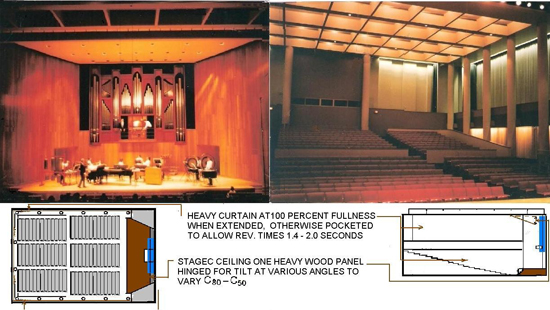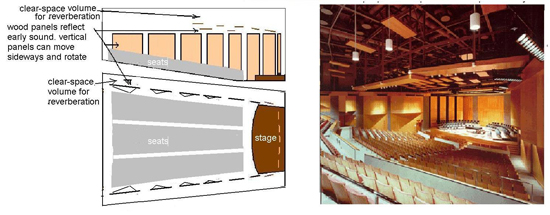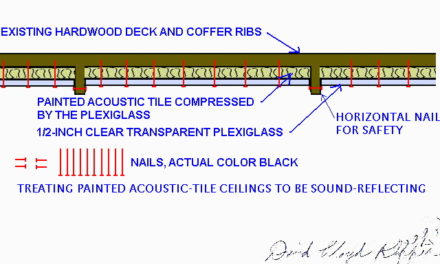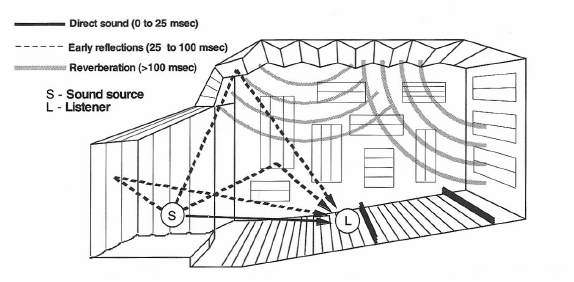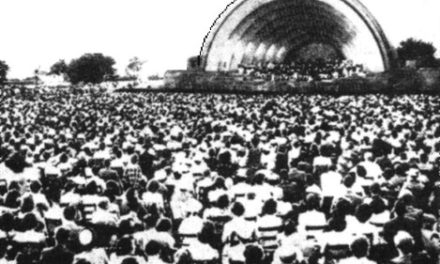by David Lloyd Klepper
Abstract
Some workers in the audio and acoustics profession still are unaware that the metric of the ratio of early-to-reverberant sound energy has largely replaced reverberation time as the primary measurable acoustical phenomenon for judging intelligibility. This metric is also defined, acoustically, as clarity (some also use definition), and 80 ms separates the two regions for music.1 This metric is abbreviated as C80. Other authors find this metric of value for both evaluation measurement and for design.2-10 Data are analyzed, showing C80 is of value and a possible replacement for early-decay time, EDT, six times the time required for sound to decay 10 dB after the source ceases. The time between arrival of direct sound and the first reflected sound, is also discussed in relation to subjective clarity. In the future, we will discuss C50 for speech.
Introduction
Wallace Clement Sabine is considered the “father of modern architectural acoustics,” and Boston’s Symphony Hall the well-loved monument to his work. He developed the reverberation time formula, used it in the design of that hall, and for many years reverberation time, T60, was considered by far the most important room-acoustics metric, complementing attention to noise control and sound isolation for successful assembly-space design. Later, L. L. Beranek proved that many post-WWII halls did not meet their design goals because audience-seating sound absorption was underestimated, with more comfortable and more widely-spaced seats. He proved that the audience-seating sound absorption should be based on seating area, not the number of seats.11,12,13
Speech acoustics give one set of criteria for optimum reverberation times for different sized halls; orchestral music another and higher set; and choral and organ music a still higher set. The subjective quality of clarity was believed directly proportional to the inverse of reverberation time for particular sized halls.
The work of P. H. Parkin and J. H. Taylor at St. Paul’s Cathedral, London, challenged this assumption for speech in 1952.14 They introduced the concept of the direct-to-reverberant sound energy ratio. In this first case, the direct sound came from a system of loudspeakers that both minimized the amount of reverberant energy and also matched time of arrival at listener’s ears with direct sound from the preacher’s voice. This concept was first brought across the Atlantic by L. L. Beranek’s test loudspeaker system in Boston’s Holy Cross Cathedral in 1954.15 W. Reichardt, U. Lehmann, A.C. Gade, J. H. Rindel, J. S. Bradley, L. G. Marshall, and others redefined the concept as early-to-reverberant ratio, a logical change because all early sound (in nearly all real situations) contributes to subjective clarity. They found 50 ms the statistically valid dividing point between early and late, and extended the concept to music, but with 80 ms at the dividing point.2-10 Thus the abbreviation C80 for an acoustic metric clarity in evaluating music acoustics.
In 1974, W. Reichardt and U. Lehmann wrote the following as an English-language summary to a German-language paper:
“As is to be expected, there is a significant negative correlation between room impression R and clarity C. The correlation factor, rCR, is, however, only −0.77. Therefore, these two quantities, R and C must he separately defined, calculated and measured. The reverberation time leads to a certain anticipated value. The initial reflections lead, however, to significant deviations from this anticipated value. These deviations, as opposed to the statistical distribution of sound in a room, give a reason for the good and poor seating positions in an auditorium.
“It is possible to enhance both room impression and clarity when reflections arrive at the ear, either laterally, or from the ceiling or the rear wall with a delay of 25 to 80 ms. The pairs of values of R and C in real concert halls group themselves around equal values of the ratios, fstat of statistical energy arriving from the front to ambient statistical energy for different reverberation times. Although the reverberation time in a room is a constant we see that for different ratios of frontal to ambient energy containing, as they do, the reflected energy, this is subjectively equivalent to a variation in reverberation time in the middle of the auditorium the frontal energy is higher and the impression clearer than would be expected on statistical distribution of energy grounds.”7
Our resulting hypothesis is that C80 is important and may replace early-decay time, EDT (six times the time required for sound energy to decay 10 dB after the sound source ceases) in importance. Other authors do consider clarity, C80, worthy of consideration in design and/or measurement in completed concert halls.2-10 Data, from both a completed multi-use hall and also from the first reference, are analyzed and support this hypothesis. Also review of these data and past work suggests that initial-time-delay gap, defined here and elsewhere as t1, may be more important for clarity than for intimacy. A recent paper presents an analysis that indicates early lateral-reflected energy may be more important than the initial-time-delay gap for a sense of proximity, although no values of t1 are given there.16
This analysis is presented in honor of the memory of Ronald McKay, a loyal friend and innovator in architectural acoustical design.22
Data
Figure 1. Valley Performing Arts Center, Northridge, California, McKay Conant Hoover, Acoustical Consultants (photo from consultants).
Figure 1 is a photograph of the Valley Performing Arts Center of the California State University at Northridge, California, for which David Conant, of McKay Conant Hoover, Inc., was acoustical consultant. It is basically a mildly fan-shaped hall, with good sightlines for all seats, and with a design intended to provide an acoustical environment close to that of a good shoe-box-shaped hall by use of angled sound-reflecting side-wall surfaces and a well-designed multi-configuration demountable stage enclosure. Detailed design considerations of this hall can be obtained from the consultants. Figure 2 plots clarity vs. reverberation time, showing a degree of independence for clarity with various configurations of this multi-use hall. The configurations are as follows:
A: Normal theatre use, no stage enclosure, scenery on stage, most adjustable sound-absorption in use, but none that block early sound reflections..
D: Normal opera use, except possibly for orchestra-pit floor position, scenery on stage, no stage enclosure, no adjustable sound-absorption employed.
E: Normal orchestral use, full stage enclosure, no adjustable sound-absorption employed.
- Partial-depth stage enclosure behind the house curtain, with overhead-side “banner” sound absorption, partially adjustable wall absorption, this configuration useful for performing amplified Pop-music groups on forestage. Note that some overhead and side absorbing treatment must be blocking early reflections, through both absorption and moderate sound-transmission-loss, resulting in loss of clarity simultaneous with some reduction in reverberation time.
I: As in “F” above with added “traveler curtain” overhead absorption added, used as above with similar results.
1. As in “I” but with full-depth stage enclosure behind the house curtain and double the number of banners exposed, but no blocking of major early reflections.
Figure 2. Clarity, C80 and fixed reverberation-time characteristic, Valley Performing Arts Center, for conditions noted in the text (from the consultant’s data).
Bold-faced data in Figure 2, “D” and “E,” show a 2 dB change in the C80, with only a negligible change in reverberation time. Based on measurements in other halls, as reported in the first reference, we would expect a one decibel shift to a higher ratio, a less negative ratio, in both conditions, and a 200 ms drop in mid-frequency reverberation time in both conditions, with the differences between them retained, when the hall is occupied. The other data demonstrate that in special cases, it is possible to decrease C80 while decreasing reverberation time.
Virgil Fox brought his massive touring electronic organ to the Neiderlander Organization’s Pine Knob Performing Arts Center, in Michigan, similar in design to the revised Tanglewood Music Shed. He asked: “Is there anything we can do to reduce the ‘sharpness’ of my sound and increase ‘echo’?” (These were his terms. He meant subjective clarity and reverberation, of course.) No possible adjustments were then available, but they are at the Valley Performing Arts Center.
Figure 3. Clarity, C80, plotted vs. reverberation time for concert halls where appropriate (complete data are available in Ref. 1).
Figure 3 is based entirely on data on pages 585 through 618 of the first reference. The data is for the average of the 0.5, 1.0, and 2.0 kHz octave bands, and is for empty (unoccupied) halls except where “f” is shown for full. In those cases, the empty data are shown as well. For halls with reverberation chambers, data reflect the doors to the chambers closed where possible. Otherwise, any adjustable features were set for normal orchestral concert use. Any halls omitted are omitted inadvertently and not according to any plan. Opera houses were not included unless used as concert halls with orchestral stage enclosure. The numbers for the different halls are as follows:
Amsterdam, Concertgebouw, 29
Bayreuth Festspielhaus, 39
Basel Stadt-Casino, 26
Belfast, Waterfront.Hall 7
Berlin, Konzerthaus/Schauspielhaus
Boston, Symphony Hall, 27
Brussels, Palais des BeauxArts, 12
Buffalo, Kleinhans Hall, 1
Buenos Aires, Teatro Colon, 15
Cardiff, St. David’s Hall, 23
Christ Church, Town Hall, 36
Copenhagen, Radiohuset Studio 1, 19
Dallas, McDermott/Myerson Hall, 14
Jerusalem, Binyanai HaOomah, Jerusalem Congress Hall, 9
Kyoto, Concert Hall, 17
Lenox, Tanglewood Music Shed, 28
London, Barbican-Large Hall, 2
London, Royal Albert Hall, 8
London, Royal Festival Hall, 18
Manchester, Bridgewater, 20
Montreal, Salle Wilfrid Pelletier, 16
Munich, Philharmonie am Gasteig, 22*
New York, Avery Fisher Hall, 24
Odense, Nielson Hall, 25
Osaka, Symphony Hall, 21
Paris, Salle Pleyel, 4
Philadelphia, Academy of Music, 3
Rotterdam, De Doelen Concertgebouw, 33
Salt Lake City, Abravanel Symphony Hall, 22*
Sapporo “Kitara” Concert Hall, 13
Stuttgart Liederhalle Grosser Saal, 34
Taipei Cultural Center, 30
Tel Aviv, Mann Auditorium, HeHal Hitharbut, 11
Tokyo, Hamarikyu Asahi Hall, 38
Tokyo, Opera City Concert Hall, 10
Toronto, Roy Thompson Hall, 5
Trondheim, Olavshallen, Holmesford Concert Hall, 35
Valencia, Palau de la Musica, 37
Vienna, Grosser Muskivereinssaall, 32
Worcester, Mechanics Hall, 40
Zurich, Grosser Tonhallesaal, 31
*Two halls with less than 0.05 differences in both metrics share the same number.
There is a general trend toward a higher C80 with decreasing reverberation time, but this appears only a general trend, not the direct dependence mentioned in Ref. 1. (I have not found any earlier figure showing C80 vs. T60 for numerous halls.) Table 4.2, p. 529, Ref. 1, shows a correlation factor of only −0.84 between C80 and T60. The same table shows a correlation between EDT and T60 of 0.99! How important is EDT as a separate measurement if its correlation with T60 is 0.99? This author suggests the data present a convincing case that separate evaluation of C80 is more important than evaluation of EDT.
In their analysis of European and Japanese chamber music halls, T. Hidaka and N. Nishihara state: “EDT and C80 are highly correlated,” but their Fig. 17 shows considerable scattering either side of a straight line, although less than Fig. 3 here. Apparently, they consider both worth measuring.5
Problems with Both EDT and C80, and Possible Solutions
Assume a hall that is used as a concert hall on occasion, but lacks sound-reflecting surfaces for early reflections. Other characteristics are pertinent: T60 of 2.4 s at 125 Hz, 2.0 s at 500 Hz, 1.0 kHz and 2.0 kHz, 1.7 s at 4.0 kHz, with freedom from echo through diffusion. But there are no strong early reflections: the early reflections are from musicians’ furniture and the walls surrounding the stage, well masked by the performers and furniture, and begin at 10 dB below the direct sound. Here, the EDT is very low, possibly 120 ms throughout the frequency range, time to the 10 dB drop in level from the direct sound to the first reflection! Clearly EDT gives a poor correlation with the subjective acoustics in such a space. And then when we bring in side and overhead reflectors to provide significant early reflections, as well as envelopment, the EDT lengthens as subjective music intelligibility and clarity increase. Such acoustical conditions were demonstrated without and then with the speech reinforcement system of the First Baptist Church of Chattanooga, as measured by J. Jacek Figwer.17 C80 would give an accurate picture of the original conditions and of the improvement for music in such a case (and C50 for speech). This seems a special case however, and the data at Boston’s Holy Cross Cathedral, with somewhat similar reverberant conditions and improvement using a similar sound system, shows EDT and C80 as possibly better correlated, in Fig. 6 in Ref. 12.
A similar (or reverse) problem also exists with C80 in rare cases. At the rear of a flat-floor or near-flat-floor hall the direct sound may be very attenuated, and the energy from the first reflection more than 10 dB higher than the direct-sound energy. Most often this situation exists in deep under-balcony spaces, and the difference in time of arrival of the direct and the first-reflected sound energy is miniscule, negating the problem. But in high-ceilinged spaces the time difference may be as high as 15 or 20 ms. My practice, after consultation with others (Ted Schultz and Ronald McKay among them) was to discard the initial sound and set the cursor for early-to-reverberant analysis on the time of arrival of the first reflection, the direct sound being too weak to be of importance. For EDT analysis, may there be times that the direct sound is too strong, compared to early reflections, to be included in the EDT analysis?
This paper does not include a discussion of envelopment, sense of surround, nor apparent source-width, important subjective room-acoustics qualities for music; nor are noise control and sound isolation (these are very important and well-covered in Ref. 4). The importance of making acoustical measurements in many locations in the hall, or being very astute in choosing locations, is discussed in nearly all references cited.
- USEFULNESS OF C80
Chamber-music concerts have been successful (indicated by repeated use and large audiences) in highly reverberant worship spaces, when enough early sound is provided by adding properly positioned reflecting surfaces or through electronic amplification. Examples are Boston’s Holy Cross Cathedral and New York City’s St. Thomas Episcopal Church on Fifth Avenue. In Boston, the early reflected energy and the appropriate C80 are provided by a suitable sound system based on Beranek’s 1954 experimental sound system to improve speech intelligibility in the Cathedral.15,18 The Cathedral’s permanent system was designed with the possibility of music reinforcement as well as speech, and for an ethnic Mass that uses guitars and drums in that historic and beautiful building.18
At St. Thomas,19,20 the procedures involved adding close-in sound reflectors to raise early sound and reduce reverberant sound. In one case, a complete Wenger concert “shell” was used with overhead and side-wall sound-reflecting surfaces. In another, a wall behind the performers closed off the chancel.
Returning to Fig. 3, the data located in the shaded area are only for halls that are the highest on Beranek’s ratings with thin upholstery, pages 495 and 496 of the first reference, or halls not included in the rating system because they are new or because of unusual characteristics that place them outside the category of enclosed concert halls. However, these halls have also received nothing but acclamation. Noting the data are for unoccupied halls, there is clearly an optimum range for C80, –3 dB to 0 dB. A dashed line extends the range to halls with seats with heavy upholstery. The data for the halls in Fig. 3 (where data is available both occupied and empty) suggest –5 dB to –2 dB for empty halls with thin-upholstered chairs and –4 dB to –1 dB for empty halls with well-upholstered chairs. This generally agrees with Beranek’s recommendations for analyzing data, Table 4.3, p. 536 of the first reference.
Figure 4. Varying clarity, C80 with a fixed reverberation time in a proposed concert hall
Figure 4 represents an idealized concert hall with measures allowing the performer to adjust C80 to his or her satisfaction using a motorized overhead canopy and portable stand-alone reflectors. A wide range of C80 values should be possible in such a configuration without changing reverberation time appreciably. In “a” the violinist wants maximum clarity (+2 dB) for a Kreisler’s Recitative and Scherzo-Caprice, somewhat less (+0.5 dB) in “b” for Bach chaconne, a greater tilt to reverberation (−2 dB) in “c” for the violin solo of “Ave Maria,” and then she shows her skill as an organist in “d” in a Messiaen late work maximizing a sense of “mystery.” (−4 dB). As organ soloist, the musician has her back to the audience, so they can see her feet on the pedal-board and hands on the keyboards, rather than just her face above the large organ console. Halls that have specific measures to change clarity, as well as independently changing reverberation time, include:
- Buffalo-Amherst, Slee Chamber Hall, where the entire stage ceiling can be tilted at different angles.
- Dallas, McDermott/Myerson, where the stage ceiling – front-of-hall reflector, can be adjusted for varying heights.
- Washington, DC, Kennedy Concert Hall, where overhead reflectors can be adjusted for varying heights and angles.
- St. Paul, Ordway Hall, where panels above a sound transparent ceiling can be adjusted for varying angles and heights.
Figure 5. Slee Hall at the State University of New York at Buffalo, Amherst Campus, Ulrich Franzen and Associates, Architect, Klepper Marshall King Acoustics; Organ by C. B .Fisk.
Figure 6. Wellin Hall at Hamilton College, Clinton, New York. Ewen Cole Cherry Parski Architects, Robert Davis Theater Consultant, and L. Gerald Marshall Acoustical Consultant. Photo by Robert Davis
Hopefully, the adjustable features of these halls and other halls can be used to provide additional data in the future. Data can then be shown for these halls as for the Valley Performing Arts Center in Fig. 2.
On page 672 of the fourth reference, tI, the initial-time-delay gap, is questioned as expressing the subjective quality of intimacy, since the perceived intimacy in halls noted varies in opposition to what data would predict. But there is another reason for tI to be considered important. If all the early reflected sound arrived at listeners’ ears between 70 and 80 ms (strong enough relative to initial sound to be useful if arriving early enough) after the direct music sound, the work of Bolt and Doak (based on work by Stevens and Haas) tells us it would probably be heard as an echo, not a contribution to clarity, for many genres of music.21 So clarity probably depends on tI as well as C80! The work of Bolt and Doak also suggests that any t1 less than 35 ms should be acceptable and not adversely affect music listening quality.
he author hopes that more data will be obtained on many additional halls, that more subjective evaluations will be obtained on a fair and scientific basis, and that correlation values will be more firmly established in the future.
Acknowledgments
I thank the reviewers, editors, and Mendel Kleiner for their helpful suggestions and corrections, and David Conant for important data.
References
1L. L. Beranek, Concert Halls and Opera Houses, Music Acoustics and Architecture, Academic Press., Springer-Verlag. New York, 2002, p. 523-527. Note that all acoustical terms and abbreviations used by this author are well-defined in this book, which has an excellent index and a comprehensive reference list. Available from the Acoustical Society of America.
2M. D. Egan, Architectural Acoustics, McGraw-Hill. New York, 1988, p. 98.
3J. S. Bradley, “A comparison of three principal concert halls,” J. Acoust. Soc. Amer. 89, 1176-1192 (1991).
4M. Long, Architectural Acoustics, Academic Press. New York, 2006, p. 671-674. second edition, 2013, p. 748-752. The definition of the term clarity factor as C80 is given on page 673 in the first edition and page 751 in the second edition.
5T. Hidaka and N. Nishihara, “Objective evaluation of chamber music halls in Europe and Japan,” J. Acoust. Soc. Amer. 116, 357-372 (2004).
6W, Reichardt,, A. Alim, and W. Schmidt, “Zusammenhang zwischen Klarheitsmass, C, und anderen objektiven raumakustischen Kriterien,” (Correspondence between the metric Clarity C and other objective criteria for room acoustics) Z. elektr. Inform, u. Energietchnik, 5, 144-155 (1975), Leipzig.
7W. Reichardt and U. Lehmann, “Sind Raumeindruck und Durchsichtigkeit des Hoererlebnisses im konzertsaal gegenaetze?” (Are room impression and auditory transparency in concert halls in contrast to one another?) Applied Acoustics 9, 139-150 (1976), England.
8A. C. Gade and J. H. Rindel, Akustik I Danske Koncertsaale, (Acoustics in Danish Concert Halls) Publikation Nr. 22l, Laboratoriet for Akustik, Danmarks Tekniske Hoejskole, Lyngby, 1984.
9L. G. Marshall, “An acoustics measurement program for evaluating auditoriums based on the Early/Late Sound Energy Ratio,” J. Acoust. Soc. Amer., 96, 2251-2261 (1994).
10L. G. Marshall, “An analysis procedure for room acoustics and sound amplification systems based on the Early/to Late Sound Energy Ratio,” Journal of the Audio Engineering Society,. 44, 373-381 (1995), reprinted in Sound Reinforcement, Vol. 2, Audio Engineering Society, New York, 1996, pp. 380-388.
11L. L. Beranek, “Acoustics of the Frederick R. Mann Auditorium, Tel Aviv, Israel,” J. Acoust. Soc. Amer., 31, 882-895 (1959).
12“L. L. Beranek, Audience and chair absorption in large halls,” J. Acoust. Soc. Amer., 45:1, 13-19 (1969).
13L. L. Beranek and T, Hidaka, “Sound absorption in concert halls by seats, occupied and unoccupied, and by the hall’s interior surfaces,” J. Acoust. Soc. Amer., 104, 3169-3177 (1998).
14P. H. Parkin and J. H. Taylor, ,,Speech reinforcement in St. Paul,s Cathedral,,, Wireless World 58:2, 58-61 and 58:3, 109-101 (1952), and reprinted in the Journal of the Audio Engineering Society, 54, 67-74 (2006).
15L. L. Beranek, “Sound systems for large auditoriums,” J. Acoust. Soc. Amer., 26, 661-675 (1954).
16A. Kuusinen, J. Patynen, S. Tervo, and T. Lokki, “Relationships between preference ratings, sensory profiles, and acoustical measurements in concert halls,” J. Acoust. Soc. Amer., 135-1, 239-250, (2014).
17J. J. Figwer, “A new method for evaluating the effectiveness of sound amplification systems in reverberant spaces,” Journal of the Audio Engineering Society, 17, 416-418 (1968), reprinted in Sound Reinforcement, Audio Engineering Society, New York, 1978 pp. A13-15.
18D. L. Klepper, “The distributed column sound system at Holy Cross Cathedral, Boston, the reconciliation of speech and music,” J. Acoust. Soc. Amer., 99:1, 417-425 (1996).
19D. L. Klepper, The acoustics of St. Thomas Church Fifth Avenue”, Journal of the Audio Engineering Soc. 43:7/8, 99-601 (1995), also Sound Reinforcement Vol 2, Audio Engineering Society, New York, 1996, pp. 392-394.
20C. Whitney and D. Clayton, 147th Meeting, 75th Anniversary, Organ Recital (program). Acous. Soc. of Am, Melville, NY, p. 1 (2004)
21R. H. Bolt and P. E. Doak, “A tentative criterion for the short-term transient response of auditoria,” J. Acoust. Soc. Amer., 22, 507-508, (1950).
22Ronald McKay was a pioneer in the design of fan-shaped halls that used angled wall panels and overhead reflectors to approximate the acoustical conditions of rectangular concert halls. Pasadena, CA, Ambassador College Auditorium, is an early example. The tent-shaped ceiling at Marie Debato Hall, Notre Dame University, South Bend, is another innovative design. He was the main acoustical consultant to the Wenger Corporation for the early development of the modular prefabricated practice rooms. He was an early advocate of using air casters for moving orchestral stage enclosures in multi-use halls, and pioneered use of high-sound-rated doors and movable walls in performing arts projects, for greater usefulness of space. An application is the use of the wing space of a theatre to construct scenery while rehearsals can take place without sound interference. More information can be obtained from the book, Sound Ideas, a history of Bolt Beranek and Newman, and from McKay Conant Hoover, acoustical consultants. D. Malon and E. Wood, Sound Ideas, Acentech, Cambridge, MA, 2005, pp. 60, 73, 118, 186, 326-328, 335.
23A new reference, published since this paper was posted; L. L. Beranek, Concert hall acoustics, recent findings, J. Acoust. Soc. Am. 139, 1548 (2016). Considering the great importance of Dr. Beranek’s earlier contributions to concert hall acoustics, any new material is essential reading. I found no contradictions between any of the new data and the ideas presented here. The tent-shaped-ceiling halls, South Bend’s Mary de Bado Hall at Notre Dame University, and the Maltings, Snape England, and the tent-shaped ceiling of the Tokyo Opera City Concert Hall are not discussed, and one is left with the impression that the shoe-box is the only road to successful concert-hall design. One may question the conclusions of the Kirkegaard experiment reported. Compare with the Beranek’s discussion of diffusion, p. 521-524, and note the difference in low frequency reverberation time, Avery Fisher Hall,. p. 590, Carnegie Hall, p. 591, L. L. Beranek Ref. One. The question of whether adding the small-scale diffusion characteristic of the side walls of Avery Fisher Hall, also Boston Symphony Hall and other classic shoe-box halls,.to the large-scale low-frequency diffusion provided by Carnegie’s side balconies, would be advantages, is still a question in my opinion.
About the Author
David Lloyd Klepper is currently a student of Rabbinics at Yeshivat Beit Orot, Jerusalem, Israel, having moved to Israel in 1996 from his position as President of Klepper Marshall King, White Plains, NY, Acoustical Consultants, and as Adjunct Professor of Architectural Acoustics at City University, New York City. Before 1971 he was a senior consultant at Bolt Beranek and Newman, starting his consulting career there in May 1957. He received his SM and SB degrees in Electrical Engineering from MIT, and between times served as Assistant Audio-Radio Member of the PsyWar Board at Fort Bragg, NC, during the Korean conflict, leaving active duty as a 1st Lt. He provided acoustical advice for over 200 worship space buildings, including the National Presbyterian Church, Washington, DC, St. Thomas Church Fifth Avenue, New York City, the Capetown, South Africa, Anglican Cathedral, River Road Baptist Church, Richmond, Virginia, Young Israel of Southfield, Michigan, and Boston’s Holy Cross Cathedral. In this capacity, he was a pioneer in application of digital delay and electronic simulation of reverberation in worship spaces, and pew-back speech reinforcement. Publications include 40 papers in professional journals, a coauthor with Professor Kleiner and Father Rendell Torris of the book Worship Space Acoustics, JRosspub.com., and Editor of the two Sound Reinforcement Anthologies of the Audio Engineering Society. He is a fellow of both the Acoustical Society of America and the Audio Engineering Society, past Emeritus Board Certified member of the Institute of Noise Control Engineering, and a member of both the American Guild of Organists and the Organ Historical Society. He also belongs to a number of railroad and public transit interest organizations. You may contact Klepper at ddaveklepper1@gmail.com.
Editor’s Note
A companion paper entitled, “An Autobiographical Assessment of the Importance of the Early-to-Reverberant Sound-Energy Ratio, “Clarity,” in Speech Acoustics”, by David Klepper, may be found here.





